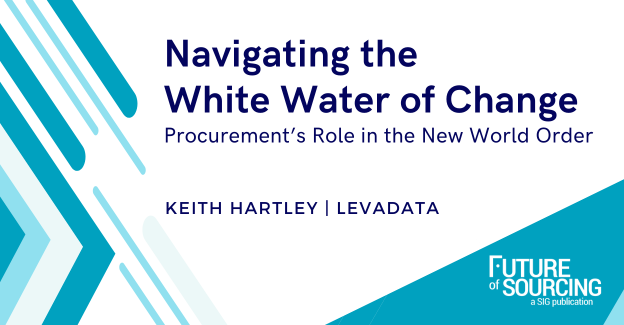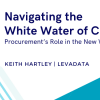In Design Unbound Vol I, John Seely Brown coined the phrase “navigating the white water” to describe working through complexity with speed and agility. His analogy of a kayaker paddling through unknown waters works perfectly to describe organizations weathering our currently turbulent economy.
As he says in his book, “Today, with the sheer number and scale of forces in play, the pace of change, and the connectedness that creates radically contingent relationships between things, a different analogy has emerged. The white-water kayaker does not have the luxury of time or contemplation, but moves through an environment of highly dynamic flows, deeply embedded in an environment where conditions and constraints change quickly and continually. Diverse forces generate different, often unexpected, conditions. New information enters the system from all directions, seen and unforeseen.”
Before the COVID-19 pandemic, manufacturers enjoyed a globalized, just-in-time supply chain that ensured efficient distribution of low-cost parts and products to every market. Even when disruptions occurred, supply chains usually recovered before the next shock. Now, with a recession looming amid persistent high inflation, extreme weather events, rising interest rates, international conflict, and talent shortages thrown into the mix, procurement leaders face unprecedented “white water.” The typical approaches used to solve past challenges continue failing amid the successive shocks happening now and those projected to continue for the next decade.
Cost Reduction vs. Cost Avoidance
In today’s world, products are designed before engaging with procurement and sourcing teams on a crucial activity: supplier selection for the needed parts. Traditionally, there is little communication between product development and the procurement team. As production begins, procurement initiates some form of a cost reduction strategy. Most procurement teams today operate this way . . . not getting involved until after product design is completed and then focusing most of their resources on cost reductions after product launch. Unfortunately, 70 to 80% of a product’s cost is associated with the design process. Therefore, procurement can only affect a small fraction of cost without going back to the design stage. Redesigns increase development costs and delay time to market. Furthermore, this lack of communication means procurement can’t help with things like end-of-life issues, unexpected supply challenges, or material constraints until it’s too late.
Research conducted by LNS Research found that the average manufacturing organization invests 25% of its personnel in new product introduction (NPI) and introduces a new product to the market in an average of 24 months. Yet 44% of NPIs fail to meet all or even most success criteria. It turns out collaborating with the procurement and sourcing functions early in the product design phase can help.
What if product development invited procurement staff to participate early in the design process — long before going to production — so they can collaborate on cost avoidance? Procurement teams engaged in the earliest design phases can help identify risks such as single source suppliers, suppliers that cannot meet quantity requirements, or suppliers with too many proprietary components. These supplier issues can be resolved before the design has been completed, saving redesign costs and potential product launch delays.
Collaboration provides real, quantifiable value to the bottom line. For example, early procurement collaboration with the product development team can reduce the costs of a product by up to 20%. And according to a Bain & Company research study on product design, cross-functional teams reduce costs by 38% more than single-function teams.
By working together, sourcing managers and product designers can use their aggregate expertise to better specify substitute components, create part standards across multiple products to simplify production, and even diversify the supplier list by sourcing from multiple regions to minimize vulnerability to geographic disruptions. Because circularity and sustainability of a product starts at the design stage, collaboration between product design and procurement helps identify the most suitable components and materials.
With early collaboration between the product development team, procurement, and suppliers, cost avoidance better manages product costs so little time needs to be spent on cost reductions after the product has launched. In fact, companies that involve suppliers early see on average a 20% reduction in material costs, a 20% improvement in material quality, and a 20% reduction in product development time, compared to companies that do not involve suppliers early.
Kearney conducted a survey that strongly supports the case for positioning procurement more strategically in the organization. C-suite executives see the value, as 92% of CFOs think procurement has met or exceeded expectations for controlling costs in times of crisis. And even though 80% of the C-suite executives surveyed report that procurement has made strategically valuable contributions, only 31% believe procurement is proactively driving strategic agendas. What that means is the perception of procurement as a firefighting asset to be activated whenever there is a need remains unchanged. What is interesting, though, is that the leading companies in the global study embraced strong collaboration across procurement, the C-suite, the supply chain, and other business teams to create incredible value. Compared with their peers, these companies generated nearly two times more total shareholder return, contributed 200 basis points more to the core corporate profitability measure EBITDA from third-party spend, and rebounded three times stronger post-COVID-19.
Shifting Focus from Supplier Spend to Impact
Today, many traditional procurement teams focus on the suppliers that tie up the most spend, which follows the Pareto principle (focusing on the top 20% of suppliers that make up 80% of spend). The problem with that arrangement is that in times of widespread supply constraint, any part shortage, no matter the cost of the part or the tier of the supplier, can delay manufacturing and keep a product from getting to the market. In other words, to build a more resilient supply chain, we must anticipate that even the most insignificant component can affect a product.
Anticipating a shift in the balance between supply and demand and how it might impact revenue is a more strategic approach than simply focusing on spend. This is how procurement starts to reimagine its role in the organization. Strategic procurement can impart incredible top-line value to any organization.
Consider the success of Apple under the leadership of Tim Cook’s procurement-driven strategy. Before becoming the CEO of Apple, he was the chief operating officer and oversaw Apple’s end-to-end supply chain. He ensured Apple’s phenomenal growth by creating strategies to secure efficient supply to meet explosive demand. For example, he procured most of the touchscreen glass capacity for almost two years to keep it from competitors and give Apple products a huge lead in the market. His procurement strategy helped propel Apple to become the most valuable company in history.
Navigating White Water as the Balance Shifts between Supply and Demand
The sluggish growth of global economies as consumers decrease spending means the extreme supply constraints in many industries such as consumer electronics are now creating an oversupply situation. This shift will occur at different rates, but there is already a broad return to a balance between supply and demand.
As the pendulum shifts toward oversupply, as is already happening in the memory industry, supply chain managers must quickly pivot to focus on finding the best price instead of worrying about component availability. Recently, in response to current market conditions and a large oversupply of inventory, Micron announced that it will reduce DRAM and NAND wafer production by approximately 20% versus fiscal fourth quarter 2022.
As geopolitical tensions between the United States and China rise, U.S. export controls on selling American chip-making technology to China are further impacting the entire chip industry’s supply and demand balance. After all, computer chips make up China’s largest import, so this promises to put a huge dent in demand.
Although some components, such as microcontrollers, continue to exhibit longer lead times, all indications are that supply chain professionals will be chasing supply less and instead focusing again on how to get the best pricing. Each industry has its own dynamics, though.
The oil and gas industry, for instance, is affected by continued sanctions on Russia and OPEC and the coronavirus outbreak in China hampering demand there. So there is fresh volatility and uncertainty. Ultimately, supply chain professionals regardless of industry must apply intelligence to all this complexity to quickly turn insights into action. That is how companies can navigate this white water and create value despite headwinds.
Building Resilience
Although important, resilience requires more than cross-functional collaboration. Chief procurement officers who think beyond operations management create strategies that also embrace digitalization. The ability to dynamically analyze huge volumes of data in real time provides better visibility into global logistics, costs, supplier operations, shipping status, and more.
Augmented by artificial intelligence (AI), digital platforms can predict risk exposure on things like raw materials and commodities before disruptions happen. These tools can help determine how each part, whether constrained or bloating your inventory, might impact your organization’s revenue. AI-powered platforms can help engineers assess supplier health and model how key components impact the cost structure of a product. Cost managers can generate should-cost estimates when negotiating with suppliers.
Going back to the Kearney survey, the leading consulting firm discovered something we inherently know -- that leading companies successfully use technology automation for everything from requisition management and spend analytics to sourcing and supplier information management. By doing this, their teams spent less time on tactical work and more time building and executing strategy.
Collaboration is a key component of this broader vision, and so is technology. According to McKinsey, 90% of chief procurement officers consider digitalization critical to their success. With the right digital tools and a model focused on cross-functional collaboration, procurement helps accelerate speed to market. Through collaboration and digital platforms, procurement can influence product launch and contribute to increased shareholder value. Then after product launch, procurement can work with product development and suppliers to find additional cost reductions and drive efficiencies.
Procurement in a New Light
In a white-water world, if an organization wants to lead or even continue to compete in a market, it can no longer afford to leave procurement out of product design. Procurement removes costs while helping drive important corporate financials by contributing to innovation and growth. In other words, procurement is an integral part of driving an organization’s success and can be instrumental to providing significant benefit. But procurement leaders must start thinking differently about their role in the organization. They have a huge opportunity now to align with corporate goals and focus on innovation and growth. So as diverse forces generate different, often unexpected, conditions and new information enters the system from all directions, seen and unforeseen, can procurement leaders reimagine their roles?
As they do, we’ll see procurement evolve from transactional firefighter to a more strategically important role. That role is as a valued business partner and growth engine who brings along some amazing digital tools.
New market realities require transformational change, and never has there been a better time for procurement to step up to the challenge. In today’s world, procurement leaders have access to software tools that drive collaboration widely across their organization, bringing with them powerful AI-powered technology platforms. Furthermore, forward-thinking organizations understand procurement has a more important role to play in the success of the business and are already making the requisite changes. These forward-thinking companies cannot afford to maintain business-as-usual operating models in a white-water world. Can you?






